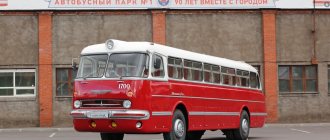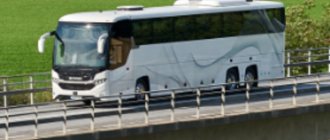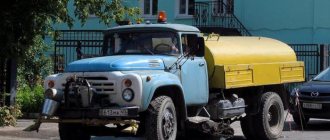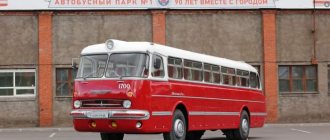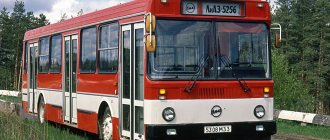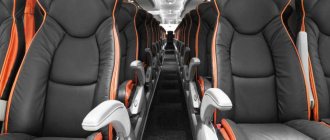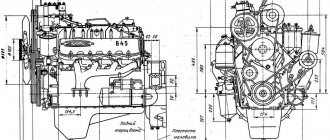GAZ-3308
GAZ-3308 “Sadko” is a Russian cargo flatbed all-wheel drive vehicle of the 2.5-ton class with a bonnet design, produced from 1997 to 2022. The following shift vehicles were produced on the Sadko chassis:
- KAvZ-39766 is an all-terrain bus using the 19-seater body of the KAvZ-3976 small class bus. Modifications: 397660 - with ZMZ-513 carburetor engine; 397663 - with diesel engine MMZ D-245.7. Produced in 2003-2005.
- SemAR-3257 is a cargo-passenger 12-seater all-terrain bus with a ZMZ-513 carburetor engine and a body from a small class bus SemAR-3280. Produced by NPP Semar CJSC in 2001-2006.
- The rotation bus on the GAZ-3308 chassis is a cargo-passenger “shift vehicle” with a separate angular body on the GAZ-3308 chassis with a standard cab. Produced in 2003-2006. at SemAR, later at the Auto-Profi plant.
- GAZ-330811-10 “Vepr” is a special-purpose vehicle on a shortened Sadko base with an all-metal three- or five-door body.
What is a “shift”?
At the ordinary level, many people imagine a rotation bus in the form of an ordinary truck, which instead of a flatbed body has a glass van with a passenger compartment. It seems so... However, this statement cannot be called truly correct, because it does not reflect the essence of the term, namely the purpose of such machines. The expression “rotation bus (or car)” is associated primarily with the so-called rotation method in the oil and gas and forestry industries of the USSR*.
*The first mention of the rotation method is found in the Regulations of the USSR Ministry of Forestry “On the organization of work on a rotational basis” dated April 11, 1974 and the Regulations on the organization of rotational logging, approved by VO Tyumenlesprom two years later. At the same time, the Ministry of Oil and Gas Construction of the USSR approved the Regulations “On the expeditionary-shift (shift) method of organizing work,” and the term “shift method” was fixed in the standard regulations. (Y.P.)
This is a form of labor organization based on the use of labor resources outside their place of permanent residence, provided that the daily return of workers home cannot be ensured. A special feature of this method is the creation of special shift camps or field camps for these workers, located, as a rule, at a certain distance from the work site. The issue of daily transportation of shift crews from the place of direct work to such a working settlement has given rise to the need to create a special class of vehicles. At first, ordinary flatbed vehicles were used, but they did not meet either the safety requirements or the comfort conditions for passengers. The use of conventional buses (where such an opportunity existed) was ineffective and costly. Firstly, because the essence of shift work implied difficult operating conditions for vehicles in remote areas, without paved roads. Secondly, the general shortage of buses in the country did not allow them to fully satisfy the need for them.
This is how the idea of creating a rotation bus was born. The new scheme had a number of undeniable advantages, including unification with trucks and a satisfactory degree of comfort at the level of PAZ or KAvZ buses for local transportation.
It is difficult to say with certainty where and when the first rotational vehicles appeared in the USSR, intended exclusively for transporting people (i.e., these do not include emergency and repair “flights”), but subsequently they became widespread in the oil and gas, construction, timber and other industries where the rotation method is used. Initially, the production of “shift cars” was spontaneous: departments had their own enterprises that produced home-grown structures, often not meeting the most basic requirements of convenience and safety.
For the first time, oil workers and energy workers started talking about centralized production of rotational vehicles. And since 1982, at the newly formed Neftekamsk Dump Truck Plant, mass production of the unified family of shift vehicles NZAS-3964 (on the GAZ-66-01 chassis) and NZAS-4947 (on the Ural-375D chassis) was launched - the first serious step towards typification "rotation shift vehicles" produced in the country and the eradication of weak structures...
GAZ-33088, 4x4, all-wheel drive: 20 seats and other characteristics
The all-wheel drive GAZ-33088 “Sadko” is equipped with a two-seater cabin and an on-board platform. The van is equipped with single-leaf side and rear doors, which are also emergency exits. 6 side windows, 1 of which can be opened (sliding). The van is equipped with a fan for forced air circulation, an autonomous Planar heater, a buzzer, and a ladder.
Description of the van
Rotational bus GAZ-33088 Sadko. Photo GAZ
The bus body has a frame-type structure . The frame is made of bent steel profiles . The outside of the body is sheathed in galvanized steel sheets , painted as standard in green or white. The inside of the frame is lined with hard fiberboard, painted light gray.
The space between the outer and inner skins is filled with embedded foam , 40 mm thick. The van's floor is made of 30 mm thick boards. and covered with black autoline. The van's doors are equipped with automotive-style locks that open from the outside and from the inside. The body has windows on the sides, the middle one on the left side in the direction of travel is sliding.
There is a blind window on the front wall of the van . All windows are installed in the opening through rubber seals. The extreme blind windows on both sides of the body additionally serve as emergency exits. The body is equipped with passenger seats , which are fastened with bolted connections through a metal profile.
Basic characteristics
- Body dimensions, mm. (LxWxH). Overall dimensions – 6250x2380x2400; van dimensions – 3370/3777x2370x1800.
- Total number of seats, including landing seats. 15+1+1/20+1+1.
- Type of seats. Separate soft with seat belts.
- Electrical equipment. Type of electrical equipment. Direct current, single wire. Negative terminals of power supplies and consumers are connected to the housing
- Rated voltage, V. 24
- Accumulator battery. 2 pcs. (6ST-110).
Specifications
As already noted, the main distinguishing feature of the GAZ-33081 truck, compared to other modifications of the all-wheel drive GAZ Sadko family, is its engine.
Unlike the basic version of the GAZ-3308, with a carburetor 130-horsepower ZMZ-5231.10 engine with a displacement of 4.67 liters; The GAZ-33081 is equipped with a turbocharged diesel engine MMZ D-245.7 with a displacement of 4.75 liters and a power of 122 horsepower.
MMZ D-245.7: GAZ-33081 engine
The MMZ D-245.7 diesel power unit of the Minsk Motor Plant consists of four in-line vertical cylinders. The MMZ D-245.7 engine fully complies with the requirements of the Euro-2 environmental standard, and its maximum power reaches 122.4 hp. at 2400 rpm.
The upper limit of engine torque reaches 417 Nm in the range from 1100 to 2100 rpm. Which, coupled with a non-alternative five-speed manual transmission, provides the truck with the ability to accelerate to a maximum “cruising” speed of 93 km/h on the highway, with an average fuel consumption of 16.8 liters for every 100 km. When driving uniformly at a speed of 60 km/h, the average diesel fuel consumption is, according to the manufacturer, 13.5 liters per 100 km.
The engine is equipped with liquid cooling, direct fuel injection and turbocharging with intercooling of the charge air. It is possible to optionally install a pre-heater, which will simplify engine starting at extremely low temperatures.
Other characteristics of the MMZ D-245.7 engine
- Cylinder diameter and piston stroke – 110 x 125 mm;
- Cylinder operating order: 1-3-4-2;
- The direction of rotation of the crankshaft is right;
- Compression ratio – 17.
- Maximum torque at a crankshaft speed of 1300-1600 rpm. – 413 (42) N*m (kgf*m).
- High-pressure fuel pump (HPF): In-line, 4-piston, spool-type, “773-20.05E2”, with all-mode speed controller, booster pump and stop electromagnet.
- Injectors: FDM-22; 455.1112010-50 or 172.1112010-11.01 closed type; injection start pressure 27.0-1.2 MPa (240 kgf/cm2).
- Pressurization system: gas turbine, with one turbocharger S14-179-01, or TKR-6.1, with a radial centripetal turbine, a centrifugal compressor and a tubular-plate type charge air cooler.
Subsequently (namely, in 2013), instead of the MMZ D-245.7 engine, diesel all-wheel drive Sadkos began to be installed with a more modern, Yaroslavl 134-horsepower turbodiesel YaMZ-53442, which belongs to the Euro-4 environmental class. As you know, the Yaroslavl Motor Plant also became part of the GAZ Group holding. The Sadko car with the YaMZ-53442 diesel engine received a different factory index - GAZ-33088.
Fuel consumption
The average fuel consumption of the GAZ 33081 model at a speed of 80-90 km/h is 16.5 liters. At the same time, the fuel tank holds up to 105 liters.
GAZ-3309 on GAZ-33098 chassis
Shift bus GAZ-3309. Photo GAZ
The GAZ-3309 15-seater rotational bus is used to transport work crews and equipment (a 20-seater version can be supplied). The insulated van is lined with clad metal on the outside, lined with decorative chipboard panels on the inside, and the insulation is made of polystyrene foam. The car has single-leaf side and rear doors.
The GAZ-3309 rotation vehicle is sold complete with a spare wheel, spark plug and wheel wrenches, a screwdriver and a jack. The price of the car may vary depending on the configuration, which is specified in the purchase and sale agreement. The rotation vehicle can be equipped with a ladder, a fan and an autonomous heater in the cabin, a buzzer and any other equipment.
GAZ-3309 has minor differences from GAZ-33088:
- Overall dimensions of the car, mm. LxWxH. 6435x2380x2400.
- Wheel formula. 4x2.
- Minimum turning radius, m. 7,9.
- Maximum speed, km/h. 105.
Clones of "Volgar"
Over the long era of TS-3966 production, many different special versions of these machines were created at different enterprises. The Kuibyshev agrochemical laboratories LAH-1 became the most widespread. And in the 1990s, many factories, in order to survive, offered their consumers various cargo-passenger versions of the TS-3966, often carried out for specific orders. This is how emergency repair service vehicles, electrical laboratories, paddy wagons and many others appeared... And this despite the fact that even the basic passenger Volgaris from different manufacturers sometimes differed noticeably from each other, for example, in wheel arches, windows, etc. This was due to the fact that that each plant modified the raw Lvov drawings in its own way.
In 1991, in connection with the transition to the new GAZ-3307 chassis, all Volgaris produced received the TS-39661 index. This was the only direct successor to the “shift” of the 1980s, and in fact just its forced modernization. At different times, however, “shift cars” were also produced in small batches or individually on other chassis, which repeated the design of the “Volgar” body. Among them is the TS-39641 rotation bus on the GAZ-66-11 chassis, produced since the second half of the 1980s. Formally, this was a modification of the northern NZAS-3964 for a temperate climate, although in terms of external features, many produced TS-39641 had a very distant resemblance to NZAS products. Perhaps the only exception are the cars produced at the Engels Specialized Vehicles Plant, the Voronezh 172nd Central Automobile Repair Plant and the Stavropol OEPO “Kinotekhnika” - they took documentation directly from Neftekamsk. Most other manufacturers (ShchDOK, SARZ, Pavlovsky Repair Plant and ZEZTS) used the standard body from the TS-3966 they produced, slightly modifying it to fit the GAZ-66-11 chassis.
If we talk about shift buses, the prototype of which was the Volgar, then there are, if not fifty of them, then certainly several dozen. A simple modular body design became the starting point for the creation of many rotation vehicles, which were subsequently produced for many years. Among them, we can highlight such remarkable and similar in design to the TS-3966 as the rotational buses of the “3210” series, developed for forestry enterprises of the RSFSR. They were manufactured at at least two enterprises - at (Apsheronsk) and Leskhozmash (Kazan). The “Volgar” also became an example to follow for the designers of the Krasnodar PKTI “Kulttekhnika”, who developed the TSK1 series of rotational vehicles. Their production in the early 1990s was mastered by AvtoKuban OJSC (formerly Krasnodar Mechanical). These are perhaps the most famous... It is simply impossible to tell more about them all within the framework of the article. Although even these two examples show how popular the Volgar design turned out to be at that time.
Versions of GAZ PARM
is equipped with a set of furniture (seats, folding beds, a table), a mobile kitchen with a sink and stove and other fittings (at the customer’s request).
Equipment Gas road master
includes a set of necessary professional equipment (metalwork, welding, gas cutting, pressing, sanding and sharpening, etc.), as well as work racks, workbenches, cabinets, etc.
Both options are also equipped with a lighting system (artificial, natural), electricity, heating (including autonomous), water supply and sound insulation.
Purpose of auto repair shops and GAZ auto watches
Automobile watches and auto repair shops based on Gas
are used for carrying out repair and restoration work on equipment and machinery (including field equipment), as well as transporting people to the place of work and organizing their temporary residence.
The list of actions performed by mobile workshops (PARMs) includes restoring the performance of engines, suspensions, electrical and pneumatic equipment, batteries, tires (tracks for tracked vehicles), transmission units, gearboxes of any type, hydraulic attachments, etc.
GAZ-3307
The rotational bus based on the GAZ-3307 GAZon has the following characteristics:
- The cabin is single-row, two-door, two-seater.
- Kung-type van body: insulation – 50mm polystyrene foam
- 6 windows: 5 fixed and 1 sliding window;
- single-leaf rear and side doors with retractable step;
- outer skin – clad metal;
- flooring - autolin or linoleum;
- internal lining – decorative fiberboard;
- lighting.
All-terrain vehicle GAZ-33081
The bus based on the GAZ 33081 “Sadko” is designed for work on a rotational basis, for transporting work crews with equipment to hard-to-reach places and remote places from residence. A car with excellent cross-country ability, the body is made of a frame method from bent steel profiles, sheathed in clad metal, which provides it with high corrosion resistance. The inside of the body is lined with fiberboard, and 40 mm foam is used for thermal insulation.
Shift bus GAZ-33081. Gird Photos
The watch has front (behind the driver's cabin) and side windows, which are installed on rubber seals to achieve lower thermal conductivity. The extreme blind windows on both the right and left serve as emergency exits. The middle window on the left side (if you look in the direction of travel) is sliding. During the cold season, workers will be able to quickly warm up in the rotation bus thanks to the installed heater, which maintains a comfortable temperature.
Modifications
Basic characteristics
Number and type of doors. Single-leaf side, single-leaf rear.
Specifications
- Fuel type. Diesel.
- Curb and technically permissible weight, kg. 4050/3615 and 6300.
- Steering type. With a steering mechanism of the “screw-ball nut” type, with a hydraulic booster.
- Brake system. Working. Double-circuit, with hydraulic drive. Parking lot. Transmission.
Chassis characteristics
- Brand. GAS.
- Wheel formula. 4x4.
- Wheelbase, mm. 3770/4570/5070.
- Ground clearance/ground clearance, mm. 315.
Engine/powertrain characteristics
- Model. MMZ D-245.7; YaMZ-5344.
- Type. Diesel.
- Number and arrangement of cylinders. 4, in-line.
- Environmental safety standards. Euro-4.
- Working volume, l. 4,75; 4,43.
- Engine power, kW (hp)/min. 92.2 (125.4) at 2200 rpm; 99 (134.5) at 2300 rpm.
- Maximum torque, Nm/min. 417 at 1100-2100 rpm; 417 (42.5) at 1200-2100 rpm.
- Checkpoint. Five-speed manual synchronized.
- Front-rear axle suspension. Dependent spring, with hydraulic shock absorbers - Dependent spring, with hydraulic shock absorbers.
- Control fuel consumption at 60 km/h, l/100 km. 17-19.
- Maximum speed, km/h. 90.
Rotation bus
Buy special buses
Crew bus on the GAZ-3308 or GAZ-3309 chassis.
Model discontinued
- Photos
- Base car
- Van Watch
- Equipment
- Price
- Service
A rotation bus is a van on a GAZ truck chassis, equipped for transporting passengers. Shift trucks are transported by work crews on roads with and without pavement.
Base car
The rotation van is installed on the chassis:
- GAZ-3308 Sadko is an all-wheel drive all-terrain vehicle with single-pitch off-road wheels, self-blocks and a tire inflation system. Cross-country ability champion in the GAZ line;
- GAZ-3309 is a rear-wheel drive car with dual-slope rear wheels, adapted for driving on a dirt road;
- GAZ-33086 is an all-wheel drive hybrid of GAZ-3308 and GAZ-3309. It has dual-pitch rear wheels, an aggressive tread and increased cross-country ability;
- GAZ-C41R13 Lawn-Next is the successor to the GAZ-3309, a modern rear-wheel drive truck with a comfortable three-seater cab. Available in an urban version on small wheels and a universal one, which is suitable for driving on dirt roads.
All medium-duty GAZ vehicles are equipped with a YaMZ-534 diesel power unit of Euro-5 standard. The engine was developed in Russia from domestic and imported components. The Bocsh Common Rail system was adapted to work on Russian diesel fuel, and the separator was equipped with automatic heating. The power of YaMZ-534 is 148.9 hp. With. The maximum torque of 490 Nm is available in the range of 1200 – 2100 rpm.
Van Watch
Standard equipment of a rotation bus
- The rotation van is thermally insulated with polystyrene foam, 40 mm thick, the outside is clad with metal, the inside is covered with plastic or laminated plywood, the floor is covered with auto linoleum. The bevels increase geometric cross-country ability, and the ceiling hatch serves for ventilation. The standard color of the van is white or green;
- 15 or 20 passenger seats are equipped with two-point seat belts;
- Two hinged doors are installed at the rear and on the right side of the van; boarding and disembarking are provided by folding ramps;
- Windows with sliding windows are located on the left and right sides;
- The van is equipped with a communication device with the driver: buzzer;
- The van's auxiliary heater operates independently of the engine.
Additionally
- We will install the “northern package” on the Watch: double glazing, 80 mm heat insulator;
- We will repaint the van and cabin, apply color and graphic design;
- We will install additional windows;
- Instead of a buzzer, we will install an intercom;
- We will reduce the number of passenger seats and make a cargo compartment;
- We will replace standard seats with luxury seats with three-point seat belts;
- We will install a multimedia system.
GAZ-3308 chassis configuration
- Power steering
- ABS
- Liquid preheater
- Checking the serviceability of the brakes
- Self-locking cross-axle differentials
- Tire inflation system
- Spare tools and accessories
- Spare wheel
The price for a GAZ rotational bus starts at rubles. It includes a GAZ-3308 car with a van for 15 passenger seats in basic equipment.
Send a request and we will calculate a van on a different chassis and offer additional options.
A start to life
The work on creating and fine-tuning the machine was headed by the leading designer of the project from VKEIA V. A. Ryabov, the chief designer of the State Committee for Agricultural Equipment of the RSFSR V. V. Opotsky, the workers of the Kuibyshev ARZ - chief engineer L. M. Aleksandrov and chief designer T. D. Poddubsky. The first prototype TS-3966 was manufactured by the experimental workshop of VKEIA in December 1982. During the summer of 1983, the Volgar underwent operational tests on state and collective farms in the Kuibyshev region, and in December in the mobile mechanized column No. 19 of the Kuibyshevvodstroy construction department.
In November 1983, the second prototype TS-3966 was produced, sent for laboratory and road testing at the NAMI test site in Dmitrov, and a month later both vehicles were presented to the interdepartmental commission, which, based on the results of a full range of acceptance tests, by an act dated December 27, 1983, 25 years ago, Volgar was recognized as suitable for production.
Since the beginning of 1984, preparations for serial production of Volgars began in Kuibyshev. The equipment was made and the equipment was prepared. However, the planned production from January 1985 was disrupted due to a huge number of technological shortcomings in the documentation and stocks brought from VKEIA; most of the body parts and assemblies had to be redesigned on site. Serial production of the Volgar dates back to March 13, 1985, when the first TS-3966 on the GAZ-53-12-01 chassis left the assembly shop of the Kuibyshev ARZ.
Some "Volgari" were manufactured on the basis of overhauled "lawns", which was allowed by technical conditions. In accordance with the design of the Volgar, the base chassis was subject to certain modifications: additional shock absorbers were installed on the rear suspension, a dual-circuit braking system with a 20 liter receiver for a hydraulic vacuum brake booster... What tricks did the developers of this car go to, so that with minimal intervention in the design of the base chassis, it could meet the stringent safety and ergonomic requirements for passenger vehicles. However, despite all possible attempts, it was impossible to turn the “shift” into a full-fledged bus. In order to “push through” the TS-3966 according to regulatory documents, it had to be officially registered as a “special vehicle for transporting rural work crews to sites,” i.e., not intended for work in public passenger transportation.
The operation of the Volgars has shown the high reliability of these machines. The simple design made it possible to easily service the shift trucks using the machine and tractor station of any state farm. An important factor was a satisfactory level of comfort and good cross-country ability on unpaved roads due to good load distribution along the vehicle’s axles and high ground clearance. The disadvantages of the TS-3966 include: a high center of gravity, due to which the vehicle was prone to tipping over; high step height for entering the salon; lack of direct connection “driver-passenger” (the salon was equipped only with a driver warning device about a stop).
However, even despite this, the “Volgar” turned out to be very useful and found wide application not only in agriculture, having managed to fill the transport niche where there was such an acute shortage of simple and unpretentious buses. Here I provide a list of well-known enterprises (most likely, far from complete*) involved in the production of the TS-3966 and its modifications.
1. For agriculture: Kotovsky RMZ, Krasnopakhorsky RMZ, Kuibyshevsky (Samara) ARZ, Pavlovsky repair plant (under the name “Siberia”), Sairamsky RMZ (under the name “Sairam”), Svetlograd repair plant.
2. For the construction industries: Zaporozhye Experimental Vehicle Plant, Shchekinsky DOK.
3. For public utilities: Ufa Tram and Trolleybus Repair Plant, Konotop Aviation Repair Plant.
4. For water management: Kakhovka experimental mechanical plant, Kokshetau repair plant, Kuiganyar experimental enterprise, Pinsk small-scale mechanization plant.
* Addition: Vileika repair src=»https://www.gruzovikpress.ru/article/17468-istoriya-sozdaniya-i-razvitiya-proizvodstva-vahtovogo-avtobusa-volgar-volgar-25-let-na-vahte/Images/ 11.jpg" class="aligncenter" width="717″ height="456″[/img]



